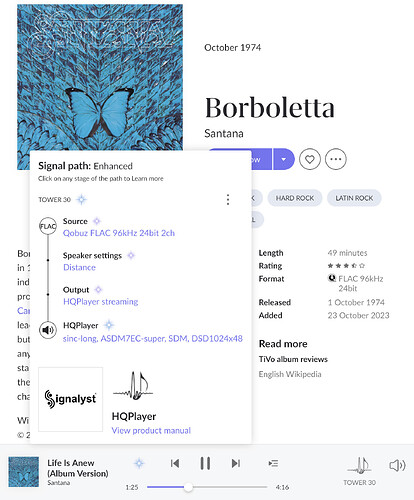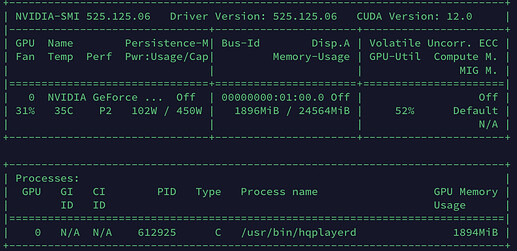Can anyone do dsd512 with sinc-long? What graphics card? I can only do medium on 1x and short on Nx with nvidia gp100 which is pretty powerful for fp64 calculations.
On latest HQPlayer version? It should work without much issues if it works to DSD256 for example.
Yeah before it was two stages, I couldn’t even do 1x with sinc-short. Since The two stage update I can do sinc-medium at 1x (all 16/48, 24/48,ect) but can manage 16/44 at sinc-large. Anything higher than 16/44 needs to be sinc-medium. Anything 24/96 or higher only sinc-short.
Ahh, yes, 176.4/192 source is 4x heavier to process than 44.1/48 source…
Any chance of a more stage sinc-large? Also how many taps are in these? Curious how they compare and differ to the sjnc-Mg/L ect.
I just noticed the FFT option.
Is there suppose to be any audible difference or cpu utilization in the number selection and in what way?
Also, if the default is 512, what would the equivalent have been prior to being configurable in 5.2.0?
Audible difference is subjective and depends on material and person. But larger values give steeper filter (faster roll-off) and smaller values gentler filter (slower roll-off). Larger values also increase CPU load.
It has been configurable always, but it was only in the configuration file and not exposed through the GUI. Since the value was there anyway already, I thought I’d just add it to the GUI, since now there is more space where to put it. The default value has always been 512.
So unless you change the value from default, nothing has changed from earlier releases apart from the value getting exposed through the settings.
It is practically same as sinc-L group, but without as much ratio restrictions. If sinc-L group is usable, you get lower CPU load with those - but more delay.
Thank you buddy, I appreciate your time. Can you expand more on ratio restriction? I notice sinc-L is more gpu ram intensive vs gpu cpu intensive for sinc-large.
I can use sinc-L around the parameters as sinc-large at dsd512.
1- Do you find the delay degrading to sound reproduction? It’s a curious thought because as I’ve optimized my audiolinux and gentoplayer for 0us latency, sound has improved. Thoughts?
2- Also - can you comment on ASDMEC7V2 vs V3? Compared to super?
3-Which is technically more correct and/or more resource intensive for more accurate shaping?
4-can we get a four stage sinc-large?
sinc-L group can do only power of two rate multiples. sinc-short/medium/long don’t have such restriction. This matters when your DAC doesn’t support DSD at multiples of 48k.
No, with Roon you notice some amount of lag between starting playback and you hearing the music. Or in particular if you seek around the tracks. Essentially you have larger buffer between input and output. Otherwise during playback the delay doesn’t have effect, since there’s plenty of delay in any case from the recording even to the playback.
So in practice it matters mostly if you use HQPlayer’s realtime input feature.
v3 is latest update of the modulator with minor tweaks compared to v2. While super/light are new designs.
From simple metrics point of view, all these are extremely good. But there are still audible differences due to how modulators work. It is more like difference emphasis on different aspects. There is no obvious metric which one is “better”.
I think light/super are best I can do at the moment, but if you prefer v2/v3 over those, it is perfectly fine from objective point of view (in particular, any EC modulator is).
So also don’t disregard “light”, it is also very good and I would say better than for example v2. v3 and super are more similar to each other while still being quite different.
It is best to give each a listen on your system, with your DAC and music and decide with one works best for your case.
It wouldn’t help anything…
@jussi_laako I have just been going through them more tonight. I do find super to be slightly better than V2 and v3 actually.
I think the non 512fs sounds better than the 512fs version despite upsampling to dsd512. The difference is subtle but definitely noticeable to the point I don’t really like the 512fs super at all. I find that quite strange. What do you think? Using a dual ess9038pro dac running in mono. My Ian Canada super dac build is in progress ![]() (end game build no expense spared.)
(end game build no expense spared.)
I can’t wait to see what you can do. The metric “best” is what I am super interested in hearing from you. Of course, content and taste really do play a role, as does your dac, but super seems to be the very best all around now. I think the sinc-medium family also is your best work.
I say about the sinc-large because before you made it two stage, I couldn’t do any of them at dsd512. Now I can do sinc-large at basic 16/44 but I really really want to do it for everything. Not many cards do fp64 better than the nvidia gp100… Have to get into the crazy territory…
Also - do you agree using a card like the gp100 is a better idea than standard nvidia cards and even crazy high end cpu because the nvidia gp100 has ecc (error correction) built in when the cpu math can have the rounding errors? Same with the likes of the 4090 ect.
following the above chit-chat, out of curiosity, I have ventured into “sinc-long” and “super” territory. Quite liked the matching with recording. At times sharply defined percussions add a bit of crisp, which I like. (Althought my “default” choice for this would’ve been “short-mp” with “7ECv3”, i didn’t regret)
GPU is nicely engaged, but with out crazy memory use:
CPU is doing just about fine, with reasonable RAM:
Staying at “ASDM7EC-super” I have circled around “short-mp”, “sinc-L”, and “sinc-long” - at this moment the latter i did like the most although differences may be subtle.
Experience with “ASDM7EC-super 512+fs” is however confusing. In a sense that from “optimized” for 512+fs modulator I also expected technical performance with SDM@1024. But no luck. It drops-out every now and than, like every 20 sec. Clearly pushing couple of CPU cores to the very edge of performance with 97-98% average utilization:
However “ASDM7EC-super 512+fs” sound signature @1024x48 made me very very curious. There’s something in it making it is very much desirable over simple “ASDM7EC-super”, that seemed more obvious in combintation with “Sinc-L”. So sonically there’s definatelly smth very attractive behind 512+fs versions @1024. But technically… can anyone do Super 512+fs@1024 in real time? @jussi_laako any chance for magic tweak?
PS: mindful that Sinc-L@1024 can be a challenge for many, would like to specify that 7EC Light and Super 512+fs@1024 drop-out with all types of different filters.
Yes, it is fine. The 512+fs ones use the available extra rate to increase SNR in sub 100 kHz region. While the regular ones have more focus on bandwidth. Depends on case which one is more optimal.
When using those sinc-short/medium/long (or sinc-L) filters, it is good to pay attention to the “Apod” counter, since those are non-apodizing filters.
ECC won’t have effect on rounding errors. It can help with random single bit memory corruptions. For example in some cases it can help avoiding Row Hammer -type attacks.
I have ECC RAM on my servers (with Xeon CPUs), but not so much elsewhere.
That would be the light 512+fs!
Healo.
I am able to do 7ec super 512+fs, 7ec super, 7ecv3, 7ec with gauss long and 44.1 rates with both 13900k and now oc’d 14900k. 7ec light 512+fs @48.
Nvidia gp100 can do absolutely every modulator and filter you want to absolutely any dsd rate you want from any family even 24/192 with gauss long and everything besides 24/96 and up to gauss long xl (although long sounds better imo)
What gpu? 4090? You can or cannot do super with sinc-long at dsd512 and up? What family can you sample up to? What about 192/24 content to dsd512?
Nvidia gp100 can do real time sinc long to dsd512 in 44/16 or 48/24 but not above that. I would like to try sinc long more but drop outs are not listenable to me.
I think the nvidia gv100 is the best bet at real time with sinc-long at dsd512 with higher rate families at 7tflops of fp64 compared to 5 tflops for gp100 without breaking the bank for an h100.
What can the 4090 cards do? What taps them out? Their tflop performance isn’t that great at all.
Hillo.
Most of my latest communication is of 1024 rates and using headphone convolution.
I had 4090 but returned it after newest Super, Long and Light variants were tested because I found it not needed for my preference settings.
Certain combos are still unachievable with 13900k/4090 in Meshilicious case and 240 liquid cooler.
I just got a 3090 again on ghe way to revisit 5.2.0 possibilities.
CUDA only helps with filters and convolution. The modulators always go through the CPU and something like ASDM7EC-super needs a high clock per channel and core.
Yes I have a 13700k all core over clocked at 5.6 with water cooling. I got it stable 4 core 6ghz and 4 core at 5.9 but brought it down as it wasn’t needed.



